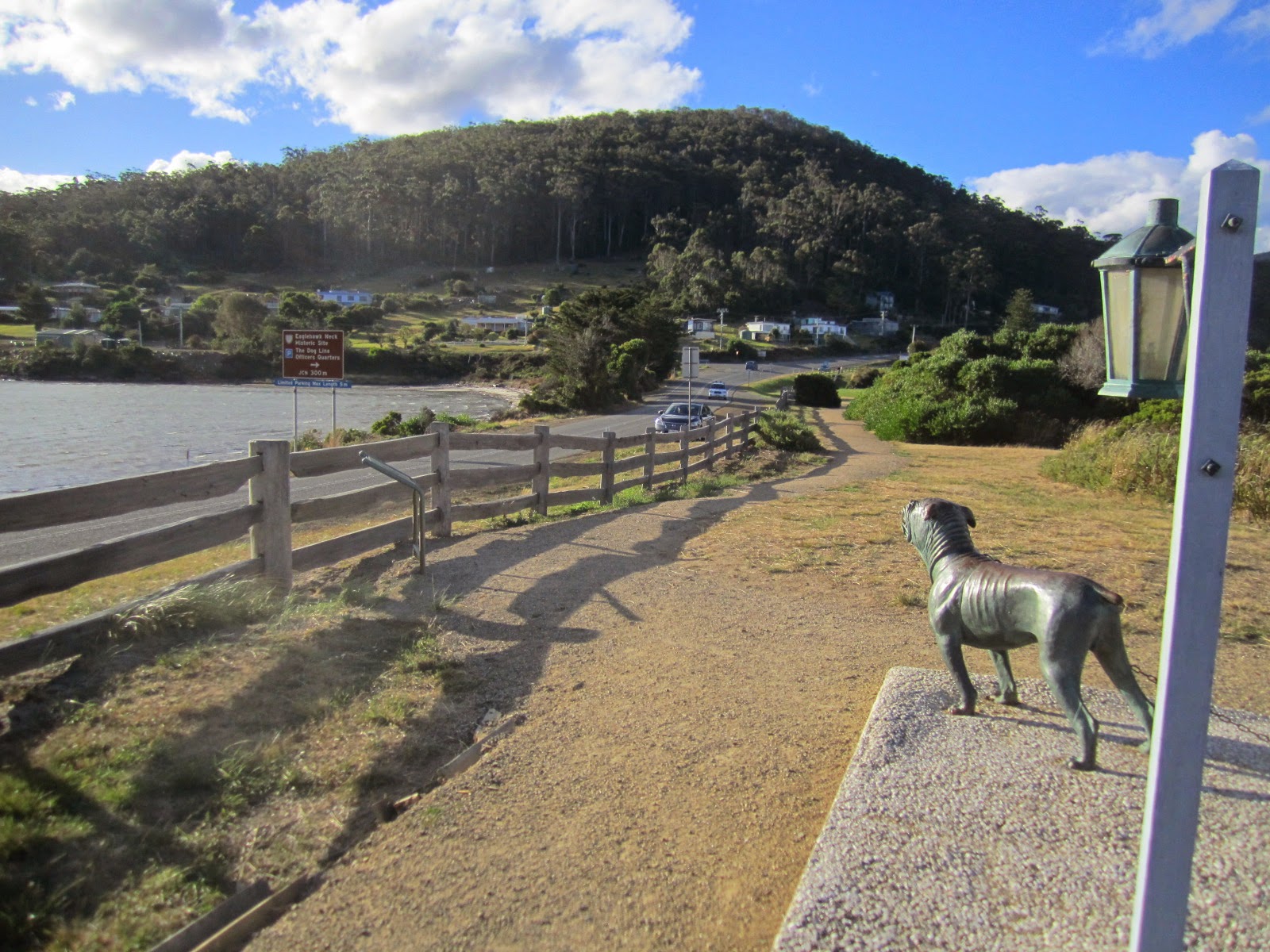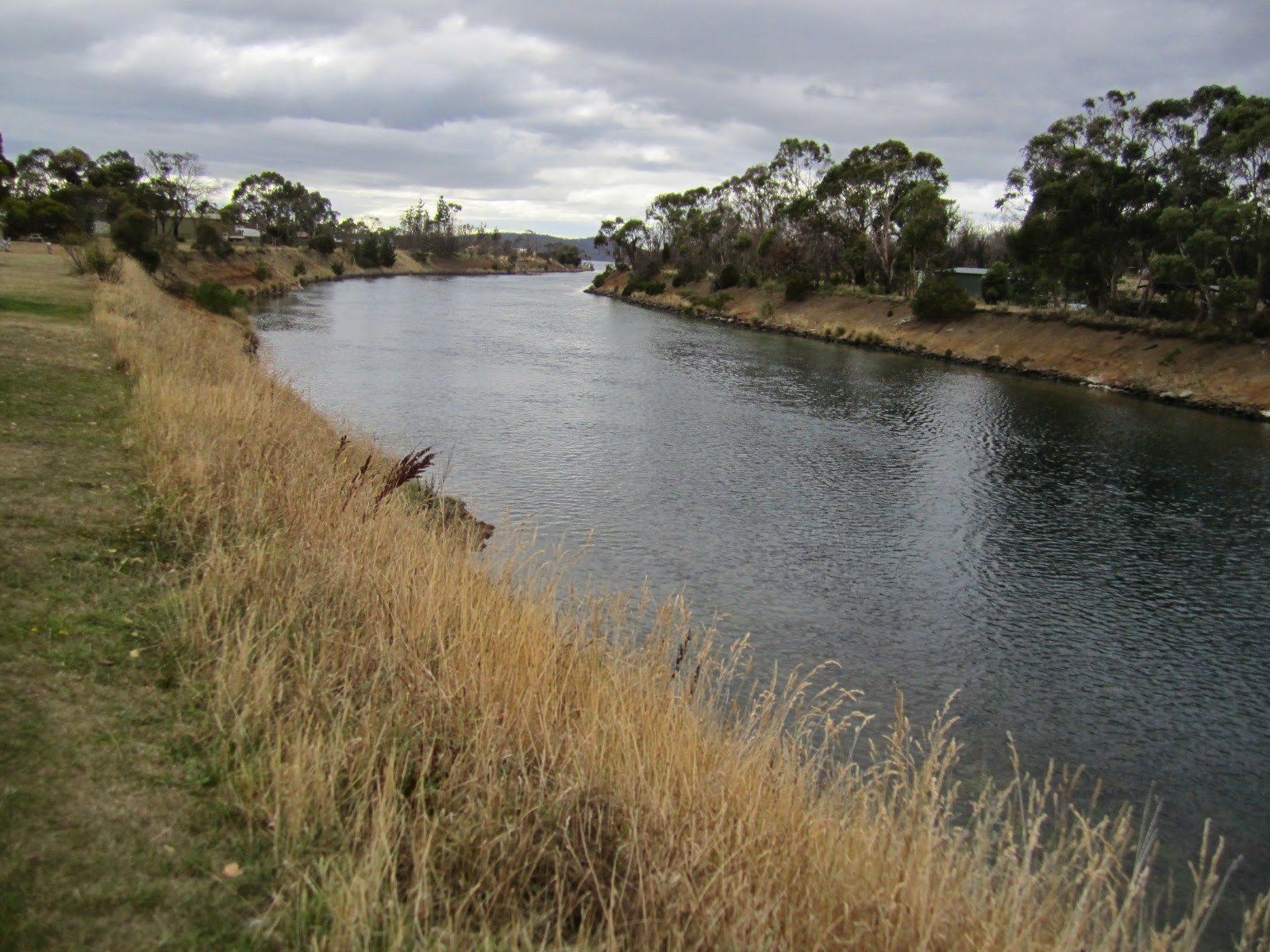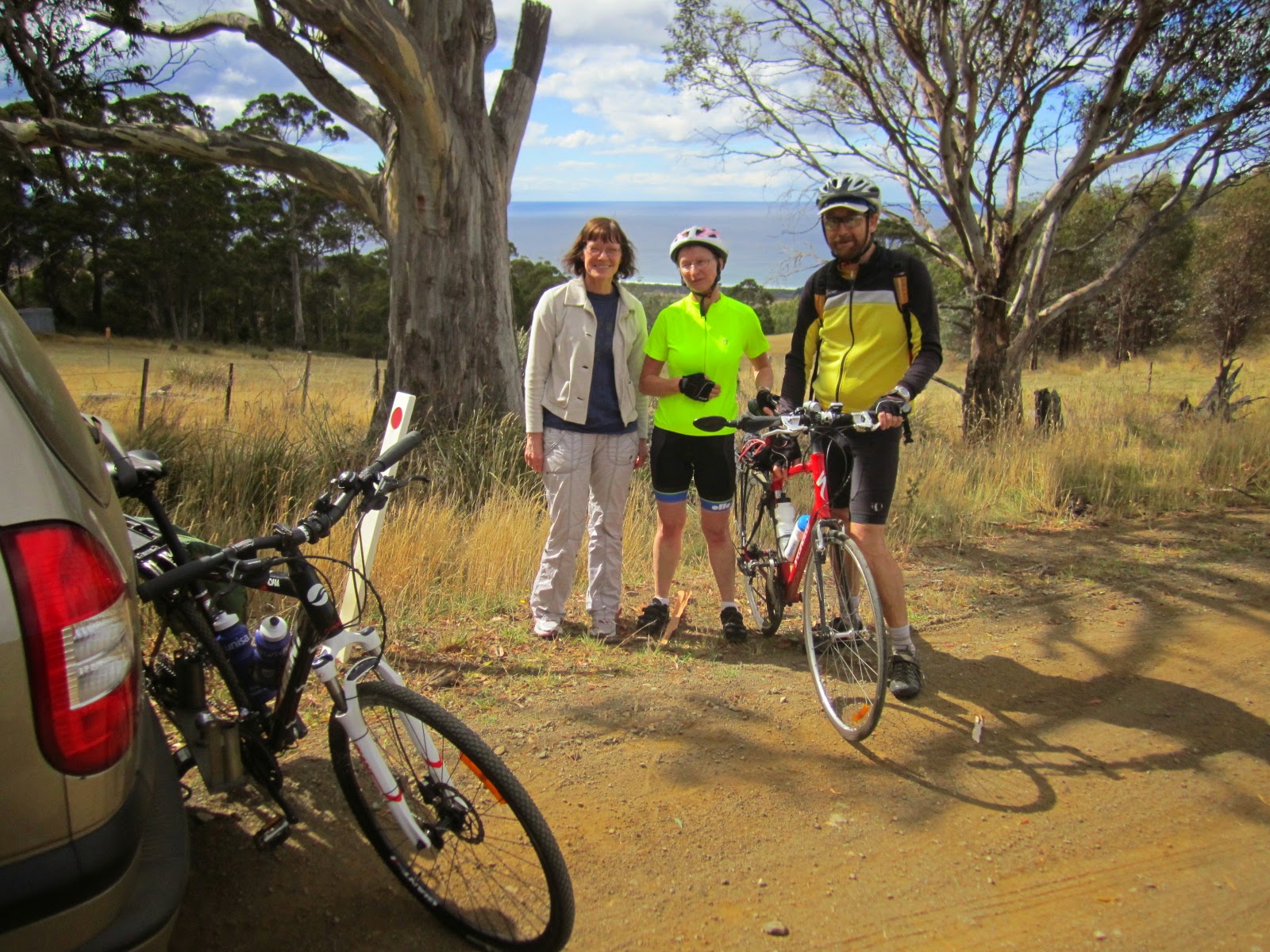The Lonely Planet Cycling Australia Guide, the source of most of
the rides in this blog, claims that Tasmania is Australia's best
region for cycle touring, owing to its stunning scenery, good quality
and lightly-trafficked roads, and the relatively short distances
between towns. However it's also one of the rainier areas of
Australia, and having a support vehicle, not only to carry the
luggage, but also to ride in if persistent bad weather intervenes, is
a big asset.
The following day we set off from Devonport by car for Hobart, stopping for lunch on the way at Ross, where we visited the Female Factory, a women's prison in the convict era:
There was also a notable old bridge there, one of the oldest in Australia:
Arriving in Hobart in the afternoon we went to the recently opened Museum of Old and New Art (MONA), which was very impressive. We had about 2 hours there before it closed but could have stayed much longer.
Saturday 15th March 2013 – Mt Wellington
The first day of cycling. The 1270m mountain right outside Hobart was a good challenging ride to start with. The others opted for shopping at Salamanca Market, but kindly gave me and my bike a lift to the start of the C616 summit road, about 10km from Hobart city centre and at an altitude of 430m. I then began the relentless 11km climb, which averages a 7.6% gradient, arriving at the summit in about 1hr 15mins. Even though the weather was somewhat overcast there were still amazing views of the Derwent Estuary from the top:
The summit of Mt Wellington is renowned for being very windy and cold; it often snows there. I didn't want to remain up there for long, so began the lengthy and hugely enjoyable descent back to Hobart, stopping en route for a tasting plate of 6 beers at the Cascade Brewery:
I met up with the others at Salamanca Place in the centre of Hobart, and shortly afterwards we set off for Eaglehawk Neck, where we were to start the cycling tour back up the east coast, and where Phil's uncle owns a beach house where we were to stay the next 2 nights:
I rode an easy 20 km down to Port Arthur, and was joined by Mavis who'd come in the car, we visited the convict site there which is a well-known tourist attraction. There's plenty to see there, besides the old convict buildings there's a new museum which tells the history of the penal settlement, and also the memorial to the 35 people killed in the massacre there in 1996.
Monday 17th March – Eaglehawk Neck to Orford
Carole, Rob and I set off from Eaglehawk Neck at 9am, heading north along the Arthur Highway.
Eaglehawk Neck is a narrow isthmus separating the Tasman and Forestier peninsulas, which was once guarded by a row of guard dogs to prevent convicts escaping. The narrowest point is marked by this memorial:
Looking back towards Eaglehawk Neck
Nearby is the Tessellated Pavement, a rock terrace resembling tiled paving, which was only partly visible due to the high tide:
After 20 km we reached Dunalley and paused briefly to see Australia's only sea canal, the Denison Canal, a short cut between the east coast and the Derwent Estuary:
Also nearby is the monument to Abel Tasman, the first European to visit Tasmania, in 1642:
Soon after Dunalley the route followed a 40 km stretch of hilly, but very scenic, dirt road, much of it led through a forest of blue and swamp gums:
We rendezvoused with Mavis for lunch at the Sandspit Forest Reserve:
There was supposed to be a rainforest loop walk here but we were unable to find it, so continued with the ride; there was no relief from the climbing:
After about 70 km the route hit the coast again at Spring Beach, where Maria Island, tomorrow's destination, became clearly visible:
We arrived at Orford at around 4pm and checked into the Blue Waters Motor Hotel which was comfortable enough. Orford is a small, low-key resort but it did have a good restaurant, Scorchers, where we had an enjoyable dinner.
Distance ridden today 81 km.
Tuesday 18th March – Maria Island
Today we made the 30 minute ferry trip over to Maria Island, a former penal settlement, now a national park, where we put in a full day's hard walking, climbing the summit to Mt Bishop and Clerk, and also doing walks around the Painted Rocks and the Fossil Cliffs.
The Commissariat's Store
Fossil Cliffs
Bishop and Clerk summit
Many wombats can be seen on the island
Painted Cliffs
Wednesday 19th March – Orford to Coles Bay
Back in the saddle again for the next stage of the ride; today's destination being Coles Bay. Following the Tasman Highway along the coast, there were no hills to contend with and the riding was easy, with sea views along much of the way:
At 51 km we reached the old convict-built Spiky Bridge which was a good place for a photo:
Soon afterwards we stopped for lunch at Swansea, where I took the opportunity to check the onward route options in the Visitor Centre. The route detailed in the Lonely Planet guide leaves the Tasman Highway shortly after Swansea and follows minor roads along a coastal spit to Point Bagot, from where, at the time the guide was written, a ferry service was available over to Swanwick, a few kms from Coles Bay. I'd been told that this ferry had ceased operating a few years ago, however I thought it was worth checking to see if there was any likelihood that if I rode to Point Bagot, there'd be boats in the vicinity which might take me and my bike across the narrow 200m estuary.
The advice from the visitor centre was that there was still no organised ferry service, but that there was a possibility that there might be a boat there willing to take me and my bike across, which would save around 45kms distance compared to the inland route. I decided to ride along the spit, following the Lonely Planet route, however when I reached Point Bagot there were no boats to be seen, and the estuary was certainly too wide to swim across:
So I had to retrace the last 16 km of the route, then continued north along the Tasman Highway, passing the Moulting Lagoon:
Turning east along Coles Bay Rd back towards the coast, it was getting towards sunset by the time I reached Coles Bay, gateway to the Freycinet Peninsula. I detoured briefly off the route to Swanwick, across the estuary from Point Bagot where I'd been several hours earlier:
After a good dinner at the Iluka Tavern we set to work on a 1000 piece jigsaw showing the map of Australia, working on it until very late in the night.
Distance cycled today 154kms, total so far 235 km
Thursday 20th March Coles Bay to Bicheno
The jigsaw was finally completed at breakfast, just before it was time to pack up and leave:
With our knowledge of Australian geography vastly improved, we set off for the Freycinet National Park, where we did several walks, the first being up to the popular lookout over Wineglass Bay:
This rock at Sleepy Bay was surprisingly difficult to climb into:
After spending the morning walking, we had lunch at the bakery in Coles Bay then set off for the short 38km ride to Bicheno. Rob set the pace and we got there very quickly, in under an hour and a half.
We enjoyed a very good dinner at Passini's restaurant.
Distance cycled today 38 km, total so far 273 km
Friday 21st March – Bicheno to St Helens
Before leaving Bicheno we took a look at the Blowhole there:
The route continued north along the Tasman Highway, which was flat and fairly quiet. After about 30 km it diverged inland over the steep Elephant Pass, climbing to 400m over a distance of about 8 km. At the summit is the renowned Elephant Pancake Barn, however it was too early for lunch so the pancakes had to be resisted:
The whole pass is heavily forested so unfortunately there weren't any decent views to be had in reward for all the climbing effort.
A few kms further on lay St Mary's, a pleasant little town with an interesting museum housed in its former railway station:
Then there was a fast descent back towards the coast, through the sprawling village of Scamander:
It was cool and overcast but fortunately the rain held off, and there was a tailwind, so the destination, St Helens, was reached by 3.15pm. We considered riding a further 24 km side trip to Binalong Bay and back, but rain was threatening so we took the car there:
In the evening we had a really excellent meal at the Blue Shed restaurant in St Helens. Expensive, but worth it; by far the best food we had in Tasmania. Although the atmosphere is nothing special, and the service not particularly friendly.
Distance cycled today 84 km, total so far 357 km
Saturday 22nd March – St Helens to Scottsdale
From St Helens the route turned inland and quickly became hilly:
After 30 km we came to a big climb over Weldborough Pass, ascending to 600m over a distance of 8 km:
Descending to 400m we reached the tiny village of Weldborough, once home to a large tin mining community, where there was an excellent pub serving a good selection of local boutique beers; we enjoyed a good lunch there:
It rained a bit while we were having lunch, so we waited a while until it stopped. The wet road, combined with a long stretch of roadworks shortly afterwards, left us and our bikes rather muddy.
The next town, Derby, had some attractive old buildings dating from the tin mining era:
The highway rolled on to Scottsdale, the largest town in north east Tasmania, our destination for the day:
Here we found accommodation at a bed and breakfast and set about cleaning all the mud off the bikes. There was a bit of trouble with the proprietor when he found us using one of his dishwashing brushes on them!
On checking Rob's bike, the rear tyre had become dangerously worn and damaged, as this photo shows:
No bike shops until Launceston, so he will have to ride on and hope it holds out.
Distance cycled today 105 km, total so far 462 km
Sunday 23rd March – Scottsdale to Launceston
The first 10 km of today's ride was through agricultural countryside, passing a series of tree-trunk carvings:
We then reached the tough 6 km climb through native forest over the Sideling Pass to a height of nearly 500m, from where there was a great view:
On a clear day Flinders Island, in the Bass Strait, can be seen from here.
From Sideling Pass it's downhill pretty much all the way to Launceston, and it wasn't long before the suburbs came into view:
On reaching Launceston we checked into the Old Bakery Inn, which had been recommended by Phil and which proved a comfortable place to stay:
After lunch we set off to explore Launceston. I spent an hour or so at the motor museum, which had a nice collection of old cars:
Next I went up to Cataract Gorge and walked the steep Zigzag trail:
Then I had a short ride around the city, seeing some interesting old buildings including Boag's Brewery:
We had a good evening meal at the Cock and Bull Hotel, close to where we were staying.
Distance cycled today 75kms, total so far 537kms
Monday 24th March – Launceston to Devonport
The Lonely Planet ride we've been following actually finishes in Launceston. However since we had to get to Devonport to catch the ferry home, it seemed sensible and worthwhile to ride there rather than taking the car.
Heading north from Launceston along the Tamar Valley highway, on reaching Legana the route branched off along the C732, a quiet road which eventually connected with the B71 running west from Exeter. Most of this road had a dirt surface:
There were no towns or facilities along the route, which passed through fertile pastureland:
It's been a great trip; we've been incredibly lucky with the weather, the car has been very useful to transport all our luggage and we're all very grateful to Mavis for doing all the driving. I would certainly recommend Tasmania as an excellent place for cycle touring, and hope to return here for more riding soon.

































































